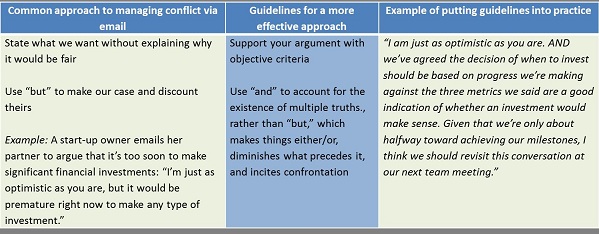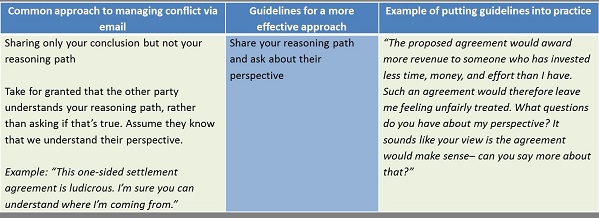
The previous article featured advice on how to set the stage for managing conflict effectively via e-mail before dealing with the substance of the issue. This article offers four tips for how to achieve your substantive goals via e-mail in a way that preserves relationships.
1. Focus on your and their underlying goals and concerns: Conflict becomes unmanageable when you and your counterparts stake out demands and lock into inflexible positions -- unfortunately, e-mail makes that quite easy to do (e.g., "The lowest ownership stake I'll agree to is 10 percent," "The most we can offer you is 5 percent)." At best, you're forced to make painful concessions that result in a split-the-difference compromise that leaves both parties somewhat unhappy. Instead, focus on the underlying goals you're trying to achieve and the concerns you're trying to address (for example, the motivation behind a demand for 10 percent ownership in a start-up company might be a desire to provide input on strategic decisions and ensure financial dividends for exceptional performance -- interests that can be satisfied in multiple ways). Share the reasons you want what you say you want and ask about their goals and concerns -- it will give both parties an opportunity to reflect before the next email exchange on multiple possible solutions that meet your and their needs.

2. Put yourself into their shoes and consider your proposal from their perspective: The prevalence of e-mail, especially short messages typed on smartphones, means that we increasingly get a "No" without an explanation. We know the other person is not inclined to do what we're asking, but we don't know why. Most often we assume they're stupid, evil, or irrational. But few people look themselves in the mirror in the morning and say, "I'm going to be stupid, evil, and irrational today." Besides, how often have you successfully reasoned with someone who was truly irrational? Assume instead that they will do what they believe is in their best interests -- regardless of whether you think it's a good idea. Consider the consequences they perceive of saying "Yes" and "No" to your initial proposal. Use your analysis to craft a new proposal that would better address their core concerns.

3. Support your argument with objective criteria: Preserving the relationship does not mean giving in. In fact, making a concession for the sake of the relationship -- for example, by replying "Fine, I'll write this month's newsletter" in response to a colleague's plea for you to be a "team player" by doing the work she had been assigned --teaches her to exploit your relationship with your colleagues whenever she needs something from you. Instead, share relevant data (e.g., delineation of activities and responsibilities in the work plan, team protocols for handling such situations, how similar challenges have been addressed in the past) that can help you settle the issue in a way that feels fair to both of you.

Your argument for how to resolve the matter is more persuasive when you build on the case your counterpart has made by using "and" to share additional objective criteria, such as industry standards and precedents, that support your argument. "But" makes things either/or, diminishes what precedes it, and incites confrontation (e.g., "I'd love to help, but this is really your responsibility.") "And" accounts for the existence of multiple truths, and helps us shift from a right/wrong mindset to a joint problem-solving one. Try bolding or capitalizing "and" in your e-mail to emphasize that you're intentionally communicating multiple, equally valid thoughts. "I'd like to be as helpful a team member as possible. AND the way I've seen us handle this issue in the past is by communicating to the analyst team why you need some help completing the assignment and what is needed from them. Let me know if you'd like any help determining how best to reach out to them."
4. Share your reasoning path and ask about their perspective: Your most difficult conversations likely sound like two football fans arguing over an instant replay. "He caught it!" "No, he was out of bounds!" In our haste to click "Send," we share our conclusion but not our reasoning path -- and we ignore their perspective. Share information that is salient to you that they may not have considered or may not have access to. And remember there may be something you are missing -- gain insight into their perspective by asking how they see it differently. A mutual understanding of how you and your counterpart view the situation differently can help you chart a path forward.

For more on these ideas, consult "Getting to Yes: Negotiating Agreement without Giving In," "Difficult Conversations: How to Discuss What Matters Most," and the consulting firm Vantage Partners (www.vantagepartners.com).
